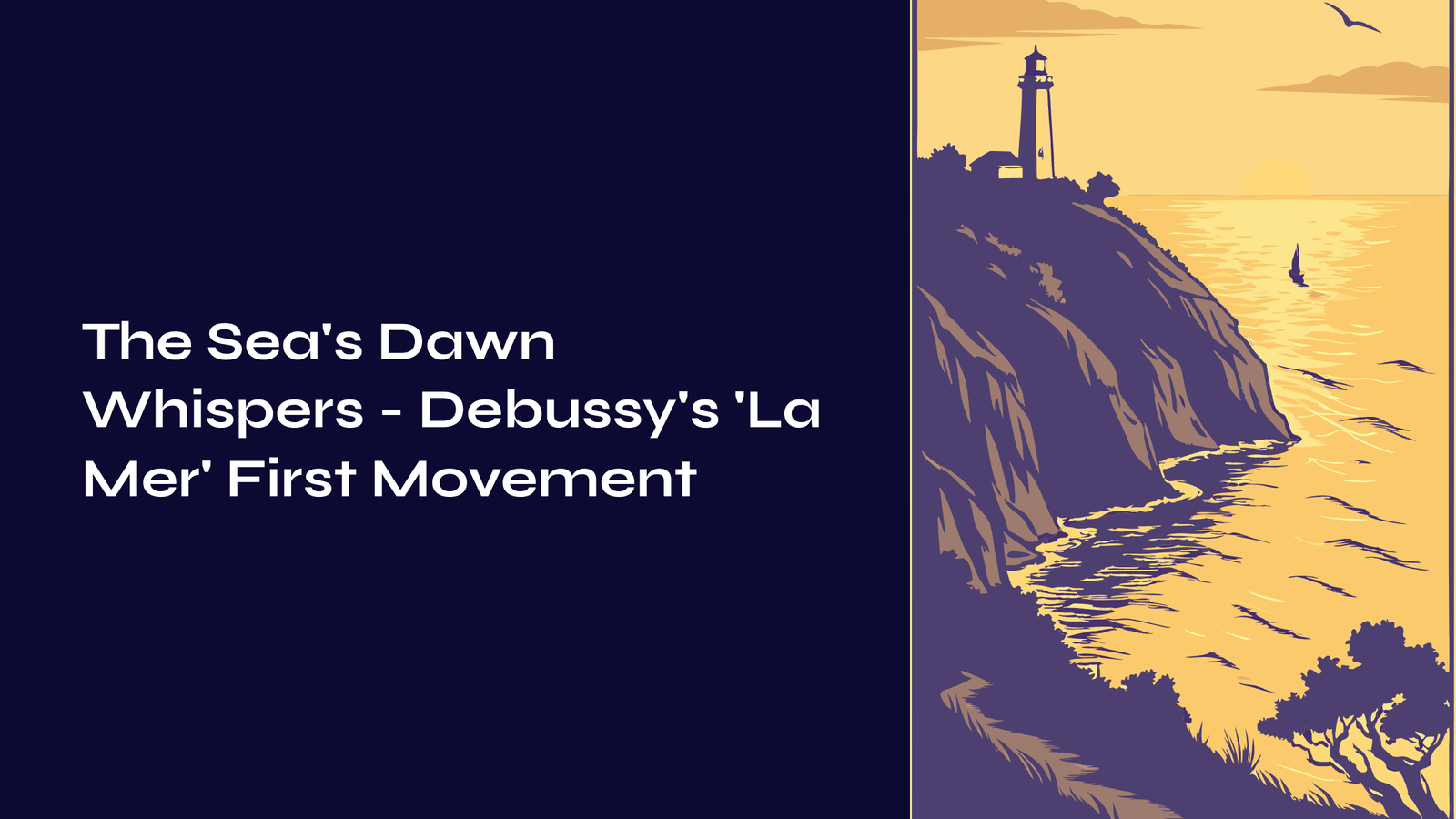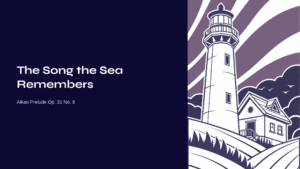Table of Contents
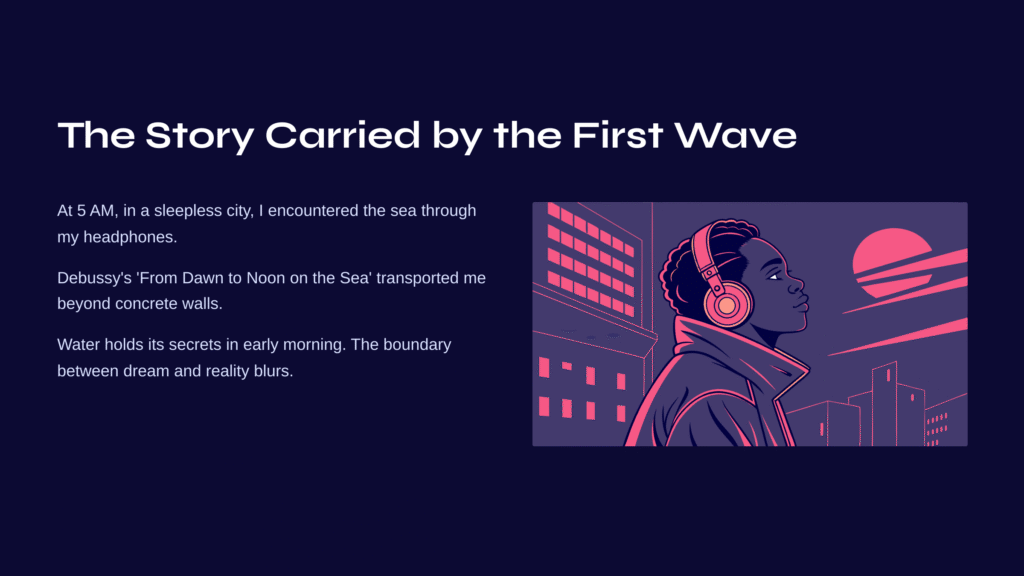
The Story Carried by the First Wave
At 5 AM, in the heart of a city that never sleeps, I encountered the sea. Beyond the concrete walls came the sounds of traffic, but through my headphones, Claude Debussy’s ocean was breathing. The moment the first movement of ‘La Mer’—’From Dawn to Noon on the Sea’—began, I was no longer in the city.
Perhaps the most mystical moment water possesses is at dawn. Light slowly seeping over the still-sleeping sea, the first breath of waves awakening with that light. Debussy captured this moment in musical notes, and we can walk between those notes to experience the ocean’s dawn.
Water holds its most magical secrets in the early morning hours, when the boundary between dream and reality blurs like mist over the waves. Debussy understood this liminal space and translated it into a language that speaks directly to our souls, bypassing the rational mind to touch something deeper and more primal within us.
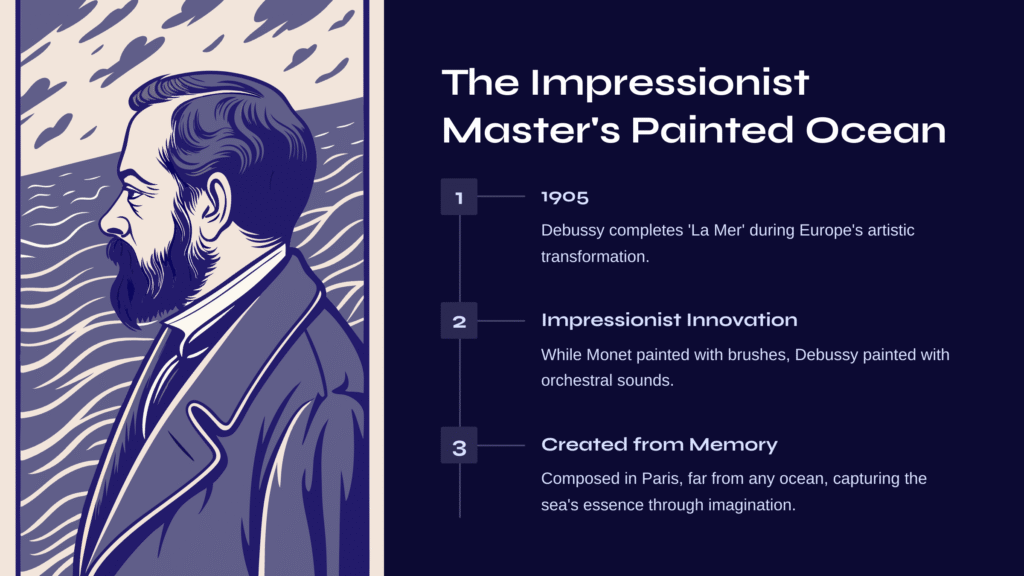
The Impressionist Master’s Painted Ocean
Claude Debussy (1862-1918) completed ‘La Mer’ in 1905. Europe was experiencing rapid transformation, and artists were breaking free from conventional forms to pursue new expressions. While Monet and Renoir were leading Impressionism in painting, Debussy brought similar innovation to the musical world.
‘La Mer’ is a symphonic poem for orchestra, composed of three movements. The first movement, ‘From Dawn to Noon on the Sea’ (De l’aube à midi sur la mer), depicts the sea awakening from slumber and gradually gaining vitality. Through this work, Debussy departed from traditional symphonic structures, attempting to translate nature’s very movements into music.
What’s fascinating is that when Debussy completed this masterpiece, he was living in Paris, far from any ocean view. He painted the sea from memory, from imagination. Perhaps this is why his music captures something more essentially oceanic than the sea itself—distilled through the alchemy of memory and artistic vision.
The composition emerged during a period when traditional harmonic language was being questioned and reimagined. Debussy’s revolutionary approach to harmony and orchestration would influence generations of composers, establishing new possibilities for musical expression that mirror the fluidity and constant motion of water itself.

The Dawn Sea’s Musical Variations
The first movement begins in profound quiet. Double basses and cellos paint the tranquil depths of the still-sleeping sea with their low tones. Above this foundation, the harp’s gentle glissandos seep in like first light bleeding over the horizon. The music here approaches near-silence—the sea holding its breath.
Soon, the flute emerges with a rising melody that feels like the ocean’s first awakening sigh. As woodwind instruments join one by one, the music gradually gains color and dimension. The oboe’s warm timbre and the clarinet’s soft resonance express the transparency of dawn air, while subtle harmonic shifts mirror the imperceptible changes in light and atmosphere.
In the middle section, the music begins to stir with increasing energy. Strings mimic wave motions through ascending and descending patterns, while brass instruments express the sun’s growing warmth. The horn’s sustained notes particularly evoke the majesty of the rising sun over vast waters, their golden tone painting broad strokes across the orchestral canvas.
The climactic section brings the full orchestra together to portray the brilliant midday sea. Over the timpani’s powerful rhythms, strings dance in glittering arpeggios while brass instruments pour forth the sun’s radiance in pure sound. This musical moment creates the sensation of walking on a sea of sunlight, where music and light become indistinguishable.
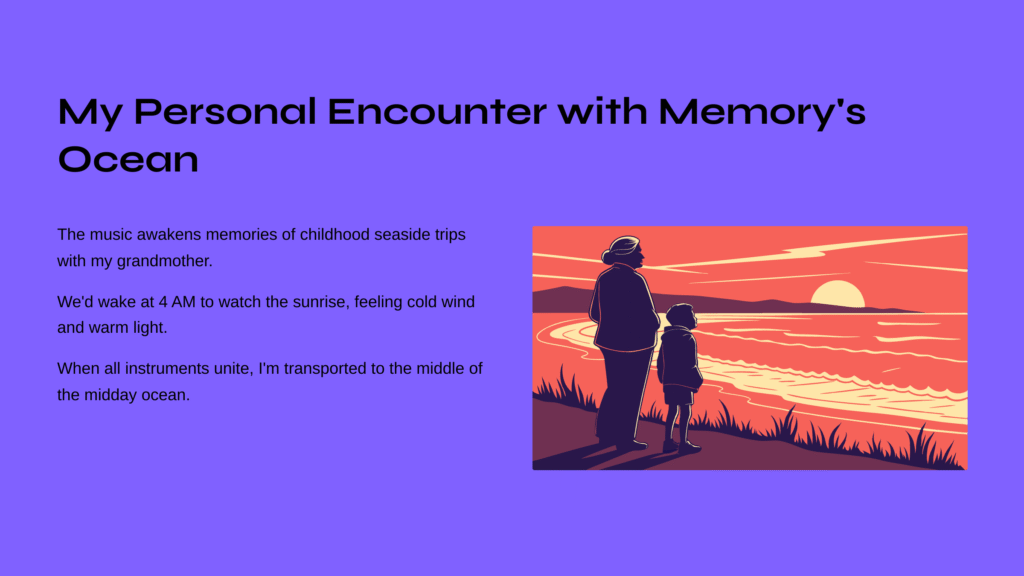
My Personal Encounter with Memory’s Ocean
When I first heard this music, I remembered childhood trips to the seaside with my grandmother. Those 4 AM mornings when we’d wake to watch the sunrise, feeling cold wind and warm sunlight simultaneously. Debussy’s music awakens these personal memories, creating bridges between individual experience and universal human emotion.
Within the music, the sea becomes more than a natural phenomenon—it becomes a living presence. It breathes, dreams, and sometimes dances with wild passion. We spend the day with this oceanic consciousness, traveling from dawn’s quietude to noon’s brilliance, experiencing the sea’s time as musical time.
What strikes me most profoundly is the music’s conclusion. When all instruments unite in majestic harmony, I feel transported to the middle of the midday ocean. Blue waters stretch in every direction, sunlight pours from above, and infinite space encompasses everything—a musical rendering of the sublime that leaves the listener forever changed.
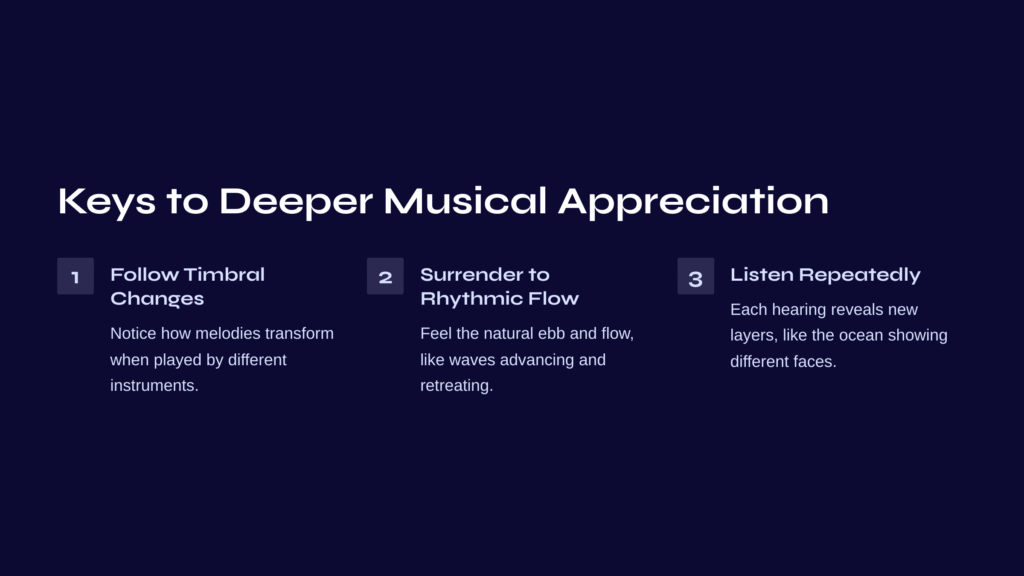
Keys to Deeper Musical Appreciation
To experience this music more profoundly, focus on several key elements. First, follow each instrument’s timbral changes. The same melody feels completely different when played by flute versus oboe. These tonal shifts are Debussy’s secret for expressing the sea’s varied moods and faces.
Second, surrender to the rhythmic flow. Rather than maintaining fixed meter, the rhythm moves like water itself—sometimes rushing, sometimes languid, always natural. Like waves advancing and retreating, the music alternates between tension and release. Feeling this organic flow is essential to understanding Impressionist music.
Third, listen repeatedly. This music doesn’t reveal all its secrets in a single hearing. Like the ocean, which shows different faces with each encounter, this composition unveils new layers with each listening. Focus first on overall atmosphere, then on instrumental conversations, finally on subtle harmonic progressions that color the musical landscape.
Consider the historical context as well—this music emerged when the very language of Western music was being revolutionized. Debussy’s innovations in harmony, orchestration, and form opened new territories for musical expression, much as explorers once mapped unknown oceans.

The Sea’s Timeless Song
After the music ends, a strange resonance lingers. It’s like awakening from a profound dream, still hearing wave-sounds in your ears. Debussy’s ‘La Mer’ doesn’t merely describe the ocean—it awakens the sea within us, the oceanic consciousness that connects all human experience to the planet’s watery beginnings.
Over a century has passed, yet the sea in this music continues to live and breathe. If anything remains constant through time’s passage, it’s the ocean’s essential nature and the human heart that contemplates it. Debussy inscribed these eternal elements in musical notation, allowing us to experience the sea’s dawn whenever we choose.
The music speaks to something beyond cultural boundaries—the universal human response to nature’s beauty and power. Whether you’ve grown up by the Pacific, Atlantic, Mediterranean, or have never seen the ocean, Debussy’s musical waves will carry you to that place where water meets sky, where finite meets infinite.
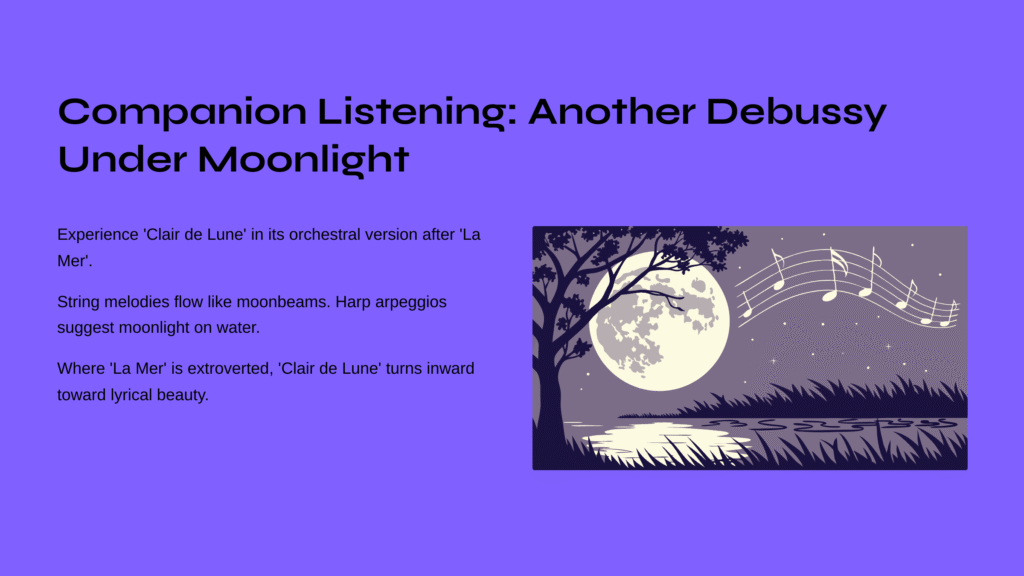
Companion Listening: Another Debussy Under Moonlight
Having experienced the sea’s dawn, why not encounter a quiet night under moonlight? I recommend Debussy’s ‘Clair de Lune’ in its orchestral version. Originally famous as a piano solo, when clothed in orchestral colors, this piece becomes even more dreamlike and mysterious.
While ‘La Mer’ portrays nature’s dynamic vitality, ‘Clair de Lune’ reveals nature’s contemplative, meditative aspect. String melodies flow like moonbeams, while harp arpeggios suggest moonlight dancing on water. Listening to this after experiencing the sea’s noon creates a natural progression from day to night, from external energy to internal reflection.
Both works employ Debussy’s unique harmonic language, yet their emotional qualities differ dramatically. Where ‘La Mer’ is extroverted and life-affirming, ‘Clair de Lune’ turns inward toward lyrical beauty. It’s like viewing the same landscape painter’s renderings of day and night—recognizable style, completely different moods.
Together, these masterpieces offer a complete journey through Debussy’s impressionistic soundworld, from the sea’s brilliant awakening to the moon’s gentle benediction. They remind us that great art doesn’t merely represent reality—it creates new realities, new ways of perceiving and feeling our connection to the natural world.
